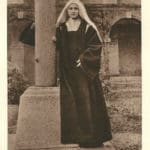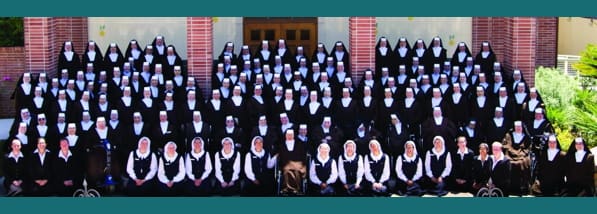Sister or Nun: What’s the Difference?
“Sister Timothy, are you a nun?” Well, I do wear a long brown habit and I have professed three vows of obedience, chastity, and poverty, in consecration to God forever. But am I a nun? My name is SISTER Timothy Marie. But am I a nun?
 Here is the answer. In a practical, everyday sense people have no hesitation about identifying me as a Catholic nun. Yet, in the technical sense of the real definition I am not. So, what am I? I have entered a consecrated life, and I am a woman religious. I am a sister. I’ll explain.
Here is the answer. In a practical, everyday sense people have no hesitation about identifying me as a Catholic nun. Yet, in the technical sense of the real definition I am not. So, what am I? I have entered a consecrated life, and I am a woman religious. I am a sister. I’ll explain.
There are many different communities of women religious, each one bringing a specific gift, or charism, to the treasure house of grace that is the Church. Each community’s charism is for the good of and at the service of the Church and her members.
Some women religious live a life of contemplation entirely enclosed in the cloister of a monastery 24/7. Their daily life usually revolves around the liturgy, the Mass and all the hours of the Divine Office, and includes time for meditation, spiritual reading, and a fair share of manual labor. Although their monasteries usually  have a public portion of their chapel where people can “join them” for Mass, you probably won’t see the religious as they will be in an enclosed portion of the chapel. The monastery may also have a parlor or two where family can visit behind a screen or grill. The enclosure is called the cloister and takes up most of the property. The religious behind that grill, enclosed by that wall, live and pray and work there for their entire lives. Even though these women bear the title “Sister” when you call them by name, they are nuns. St. Thérèse was a Carmelite nun.
have a public portion of their chapel where people can “join them” for Mass, you probably won’t see the religious as they will be in an enclosed portion of the chapel. The monastery may also have a parlor or two where family can visit behind a screen or grill. The enclosure is called the cloister and takes up most of the property. The religious behind that grill, enclosed by that wall, live and pray and work there for their entire lives. Even though these women bear the title “Sister” when you call them by name, they are nuns. St. Thérèse was a Carmelite nun.
Other women religious live a life of contemplation in the world, serving the Church in a multitude of apostolates. These consecrated women are called sisters. You will find Catholic sisters throughout the world in classrooms, operating rooms and emergency rooms, counseling centers, retreat houses, homeless shelters, and more. They live in convents and usually part of their convent will be cloistered, meaning that only they can go in (unlike the nuns for whom it means they never come out). Their life also includes the liturgy, both the Mass and some of the hours of the Divine Office, as well as meditation and spiritual reading. This life of prayer is the source of their apostolate and in turn the apostolate fuels their prayer. Venerable Mother Luisita, our foundress, was a sister. Although most communities of Carmelites are cloistered and therefore nuns, some communities like ours take the contemplative charism of Carmel and blend it with the works of the  apostolate as sisters.
apostolate as sisters.
Some people wonder why nuns are “wasting” their lives behind walls when there are so many needs in the world and other people ask sisters why they aren’t “real religious” like the nuns. Both of these perspectives show a misunderstanding of the unique beauty and value of both vocations. God calls some women to belong totally to Him in a life of hiddenness, sacrifice, and prayer in the cloister. The enclosure allows these brides of Christ to abide in the chamber of the King and make all His concerns their own. From their little plots of land, they embrace the whole world, bringing every need to His feet. God calls other women to belong totally to Him in a life of serving His children in the world, bringing His immense love to each person in concrete acts of mercy and compassion. As His hands and feet and Heart, these brides of Christ allow the people of the world to see and touch and hear Jesus say, “I love you.”
If you forget and call me a nun, its alright, because both nuns and sisters are Brides of Christ, and that is the most important thing to remember.
Originally published on the website of the Carmelite Sisters of the Most Sacred Heart of Los Angeles.
+
Art: Logo of the Carmelite Sisters of the Most Sacred Heart of Los Angeles used with permission. Gravure de “Sainte Thérèse de l’Enfant Jésus, Histoire d’une âme écrite par elle-même, Lisieux, Office central de Lisieux (Calvados), & Bar-le-Duc, Imprimerie Saint-Paul, 1937, édition 1940.”, PD-US copyright expired, Wikimedia Commons. Photograph of Mother Luisita used with permission.




